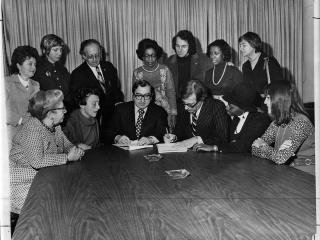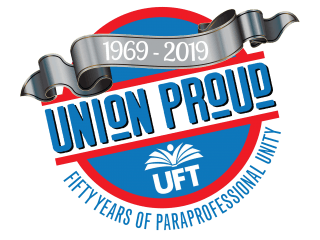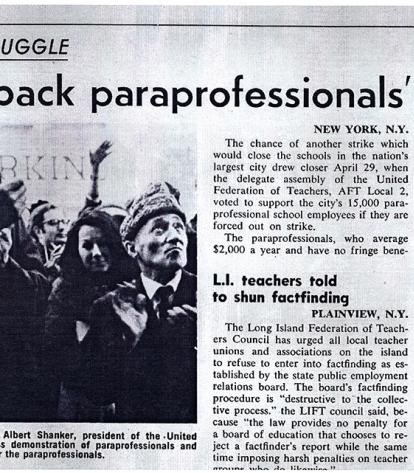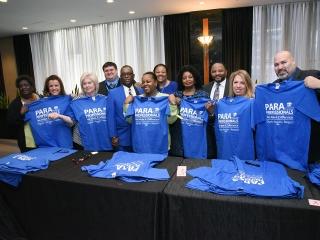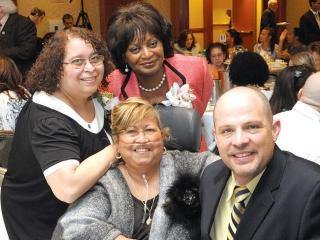Activist Velma Hill and UFT founder Albert Shanker had crossed paths in the civil rights movement. So when Hill, armed with a master’s in education from Harvard, decided she wanted to organize paraprofessionals, she approached Shanker in 1968.
To organize paras, he said, she would have to become one.
“I was very much for that,” says Hill, 80. With the union’s help, the founder and first chair of the UFT’s Paraprofessionals Chapter got a job at PS 122 in Manhattan.
This school year marks the chapter’s 50th anniversary, and its 27,000 members are men and women of all races and ethnicities.
When Hill began, paras were mostly poor African-American and Hispanic women.
Interest in teacher assistants, or paras, began to grow in the mid-1950s because of a shortage of licensed teachers after World War II and the need to develop community- based services for people with disabilities. In 1965, federal legislation created services for educationally and economically disadvantaged students, and federal funds became available to employ those assistants.
“That brought paras into the school system,” said Hill. They “had to be welfare-eligible, so they didn’t make a lot of money.” That requirement was later abolished, but Hill said it’s important “because the paraprofessional program did so much to help minority communities and to bring people to a different economic level.”
Marion Thom lived on the Lower East Side in the late 1960s and got involved in the Parent Association when her son started kindergarten at PS 126. “They asked me if I would go out with teachers to recruit kids” in the city housing projects, including children from Chinese families that didn’t speak English, Thom said.
At first, she didn’t qualify to be a para because she wasn’t on welfare, Thom said, but she got the job when that requirement was revoked. Thom, now 82, earned $1.25 an hour.
“If the school closed early, like on a snow day, we didn’t get paid for the hours we didn’t work,” she said. “There also were times when we didn’t get paid at all until the end of October.”
Like Thom, Florence Fidell volunteered when her son went to kindergarten at PS 152 in Manhattan. “They announced they were going to hire a small cadre of people and I was fortunate to get in,” said Fidell, now 89, the first para to become a chapter leader and the creator of Parascope, still the chapter’s newsletter. “I got along very well with the teachers. They liked the way I worked, and I never left.”
Lucy Nowakowski was a school aide before becoming a para in 1969, the year the chapter was formed, and remained a para until 1995, “always in the same neighborhood, Sunset Park in Brooklyn.”
School aides, who worked in lunchrooms and served as hall and book monitors, were represented by District Council 37, the city’s largest public employee union. When the paras’ organizing effort began, both DC 37 and the UFT wanted to represent them.
Most paras came from communities that had opposed the UFT and its mostly white teachers during two strikes in 1967 and 1968, and both paras and teachers were at first wary of the paras joining the UFT’s ranks.
Nowakowski, now 92, remembers the vote turning on the career ladder offered by the UFT. In 1968, the city had offered paras tuition-free college courses. But there was money only for 1 out of 10 who applied and, after a year, the popular program was cut.
Maggie Martin, who began her career in public schools as a para at PS 50 in Queens, says paras also wanted to be in the same union as teachers they worked beside.
Martin served on the negotiating committee for the first para contract in 1970. When talks stalled, Shanker wrote to teachers from jail, where he was serving a sentence for the 1968 strike. He urged them to support the paras and, in solidarity, teachers voted to strike.
That jump-started negotiations. In the first para contract, paras’ wages rose from $2,000 a year to $4,600, and they got their career ladder.
Martin used the new career ladder to complete her studies to become a teacher.
Para positions before the union were mostly “patronage,” Nowakowski says. Afterward, you couldn’t be fired “because they liked somebody else better than you,” she said.
Instead of focusing on studies, Thom channeled her energy into the UFT, where she made political action a priority.
“If it wasn’t for the union fighting for us, we wouldn’t have what we have,” said the 36-year para, ticking off benefits won over time: sick days, vacation days, health insurance, a pension, a 10-month work year with paid summers, a duty-free lunch.
Martin, whose mother ran a shirt factory, had learned a union’s value early. “She was an honest woman who worked very hard. But the hours she put in? She was never really paid enough for that because she didn’t have a union,” Martin said. “Middle class people will not and cannot succeed without a union behind them.”
